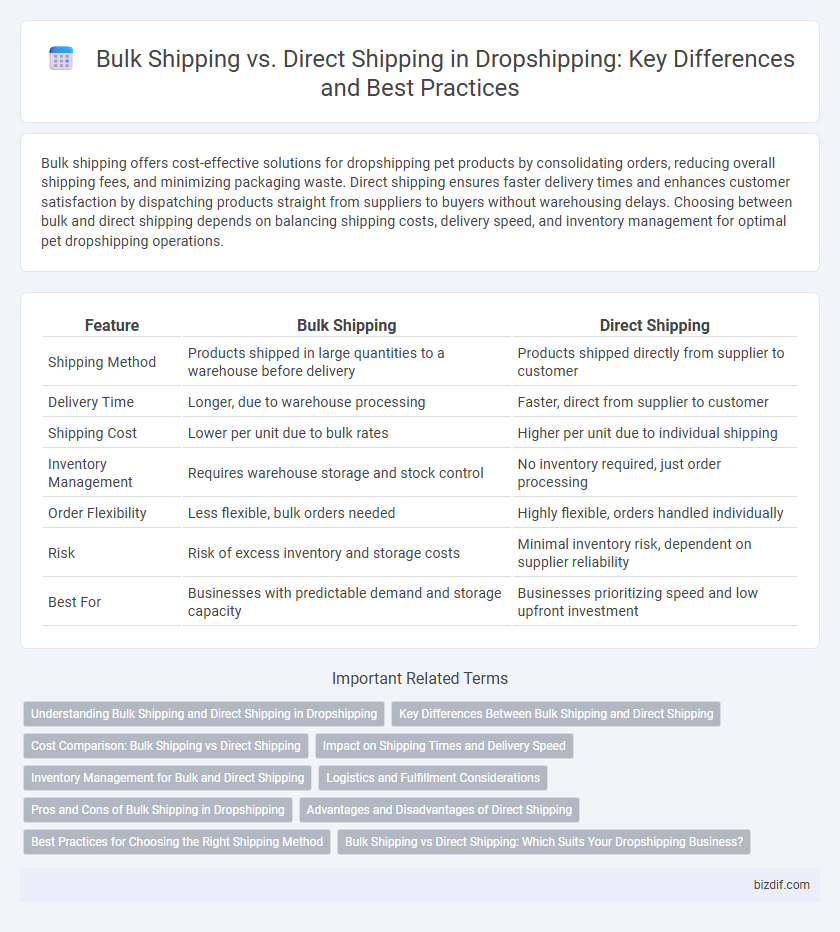Bulk shipping offers cost-effective solutions for dropshipping pet products by consolidating orders, reducing overall shipping fees, and minimizing packaging waste. Direct shipping ensures faster delivery times and enhances customer satisfaction by dispatching products straight from suppliers to buyers without warehousing delays. Choosing between bulk and direct shipping depends on balancing shipping costs, delivery speed, and inventory management for optimal pet dropshipping operations.
Table of Comparison
| Feature | Bulk Shipping | Direct Shipping |
|---|---|---|
| Shipping Method | Products shipped in large quantities to a warehouse before delivery | Products shipped directly from supplier to customer |
| Delivery Time | Longer, due to warehouse processing | Faster, direct from supplier to customer |
| Shipping Cost | Lower per unit due to bulk rates | Higher per unit due to individual shipping |
| Inventory Management | Requires warehouse storage and stock control | No inventory required, just order processing |
| Order Flexibility | Less flexible, bulk orders needed | Highly flexible, orders handled individually |
| Risk | Risk of excess inventory and storage costs | Minimal inventory risk, dependent on supplier reliability |
| Best For | Businesses with predictable demand and storage capacity | Businesses prioritizing speed and low upfront investment |
Understanding Bulk Shipping and Direct Shipping in Dropshipping
Bulk shipping in dropshipping involves purchasing large quantities of products from suppliers and storing them in a warehouse before fulfilling individual customer orders, which reduces shipping costs but requires inventory management. Direct shipping, on the other hand, allows suppliers to ship products directly to customers without holding inventory, enabling faster order processing and lower upfront investment. Understanding these methods helps dropshippers balance cost efficiency, delivery speed, and operational complexity to optimize their supply chain.
Key Differences Between Bulk Shipping and Direct Shipping
Bulk shipping involves consolidating multiple products into a single shipment to reduce costs and streamline logistics, while direct shipping sends individual orders straight from the supplier to the customer for faster delivery. Bulk shipping often leads to longer delivery times but lower per-item shipping fees, whereas direct shipping prioritizes speed and customer satisfaction at a higher shipping cost. Understanding these differences is crucial for dropshipping businesses aiming to balance cost efficiency with delivery speed and customer experience.
Cost Comparison: Bulk Shipping vs Direct Shipping
Bulk shipping reduces per-unit costs by consolidating multiple products into a single shipment, making it cost-effective for large order volumes. Direct shipping incurs higher expenses due to individual parcel handling and increased shipping fees, which can impact profit margins on smaller or single orders. Businesses must weigh the economies of scale in bulk shipping against the convenience and speed of direct shipping when analyzing overall cost efficiency.
Impact on Shipping Times and Delivery Speed
Bulk shipping consolidates multiple orders into a single shipment, reducing overall transit time and lowering costs but often resulting in longer delivery times for individual customers due to additional handling and sorting. Direct shipping sends products straight from the supplier to the customer, accelerating delivery speed by minimizing processing steps and reducing the risk of delays. Ecommerce businesses must balance shipping efficiency and customer satisfaction by choosing the method that best aligns with their operational priorities and shipping infrastructure.
Inventory Management for Bulk and Direct Shipping
Bulk shipping requires advanced inventory management systems to track large quantities of products, ensuring stock levels meet demand without overstocking. Direct shipping eliminates the need for holding inventory, reducing storage costs but requires real-time order tracking and supplier coordination to manage individual shipments. Efficient inventory management in bulk shipping supports better forecasting and reduces delays, while direct shipping depends heavily on supplier reliability and seamless logistics integration.
Logistics and Fulfillment Considerations
Bulk shipping streamlines logistics by consolidating multiple products into a single shipment, reducing overall freight costs and simplifying inventory management. Direct shipping offers faster fulfillment by sending products individually from suppliers to customers, minimizing warehousing needs but increasing per-unit shipping expenses. Choosing between bulk and direct shipping impacts delivery speed, inventory control, and cost efficiency in dropshipping operations.
Pros and Cons of Bulk Shipping in Dropshipping
Bulk shipping in dropshipping offers cost efficiency by reducing per-unit shipping expenses and simplified inventory management through consolidated shipments. However, it involves longer delivery times, which can lead to decreased customer satisfaction and potential inventory holding risks due to upfront stock purchasing. This method suits businesses prioritizing lower operational costs over rapid fulfillment and agility in responding to market demand.
Advantages and Disadvantages of Direct Shipping
Direct shipping in dropshipping offers faster delivery times and reduced handling costs by shipping products directly from the supplier to the customer. However, disadvantages include limited control over packaging quality and potential inconsistencies in shipping speed, which can negatively impact customer satisfaction. Managing returns and inventory transparency also presents challenges compared to bulk shipping methods.
Best Practices for Choosing the Right Shipping Method
Selecting the optimal shipping method in dropshipping requires evaluating factors such as product type, order volume, and delivery speed expectations. Bulk shipping minimizes per-unit costs and is ideal for high-demand products with longer lead times, while direct shipping offers faster delivery and enhanced customer satisfaction for individualized orders. Employ data analytics to monitor shipping performance and adjust strategies, ensuring cost efficiency and reliable fulfillment tailored to your target market.
Bulk Shipping vs Direct Shipping: Which Suits Your Dropshipping Business?
Bulk shipping consolidates multiple orders into a single shipment, reducing per-unit shipping costs and minimizing environmental impact, ideal for dropshipping businesses focusing on high-volume, low-cost products. Direct shipping sends products individually from suppliers to customers, offering faster delivery times and increased order tracking but often at higher shipping rates, making it suitable for niche or high-value items. Choosing between bulk and direct shipping depends on your product type, delivery speed expectations, and overall cost-efficiency strategy in your dropshipping model.
Bulk Shipping vs Direct Shipping Infographic

 bizdif.com
bizdif.com